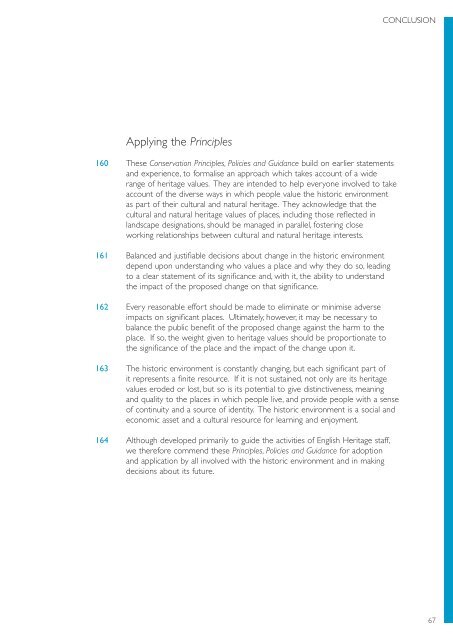Conservation Principles, Policies and Guidance - English Heritage
Conservation Principles, Policies and Guidance - English Heritage
Conservation Principles, Policies and Guidance - English Heritage
Create successful ePaper yourself
Turn your PDF publications into a flip-book with our unique Google optimized e-Paper software.
Applying the <strong>Principles</strong><br />
160 These <strong>Conservation</strong> <strong>Principles</strong>, <strong>Policies</strong> <strong>and</strong> <strong>Guidance</strong> build on earlier statements<br />
<strong>and</strong> experience, to formalise an approach which takes account of a wide<br />
range of heritage values. They are intended to help everyone involved to take<br />
account of the diverse ways in which people value the historic environment<br />
as part of their cultural <strong>and</strong> natural heritage. They acknowledge that the<br />
cultural <strong>and</strong> natural heritage values of places, including those reflected in<br />
l<strong>and</strong>scape designations, should be managed in parallel, fostering close<br />
working relationships between cultural <strong>and</strong> natural heritage interests.<br />
161 Balanced <strong>and</strong> justifiable decisions about change in the historic environment<br />
depend upon underst<strong>and</strong>ing who values a place <strong>and</strong> why they do so, leading<br />
to a clear statement of its significance <strong>and</strong>, with it, the ability to underst<strong>and</strong><br />
the impact of the proposed change on that significance.<br />
162 Every reasonable effort should be made to eliminate or minimise adverse<br />
impacts on significant places. Ultimately, however, it may be necessary to<br />
balance the public benefit of the proposed change against the harm to the<br />
place. If so, the weight given to heritage values should be proportionate to<br />
the significance of the place <strong>and</strong> the impact of the change upon it.<br />
163 The historic environment is constantly changing, but each significant part of<br />
it represents a finite resource. If it is not sustained, not only are its heritage<br />
values eroded or lost, but so is its potential to give distinctiveness, meaning<br />
<strong>and</strong> quality to the places in which people live, <strong>and</strong> provide people with a sense<br />
of continuity <strong>and</strong> a source of identity. The historic environment is a social <strong>and</strong><br />
economic asset <strong>and</strong> a cultural resource for learning <strong>and</strong> enjoyment.<br />
164 Although developed primarily to guide the activities of <strong>English</strong> <strong>Heritage</strong> staff,<br />
we therefore commend these <strong>Principles</strong>, <strong>Policies</strong> <strong>and</strong> <strong>Guidance</strong> for adoption<br />
<strong>and</strong> application by all involved with the historic environment <strong>and</strong> in making<br />
decisions about its future.<br />
CONCLUSION<br />
67

















